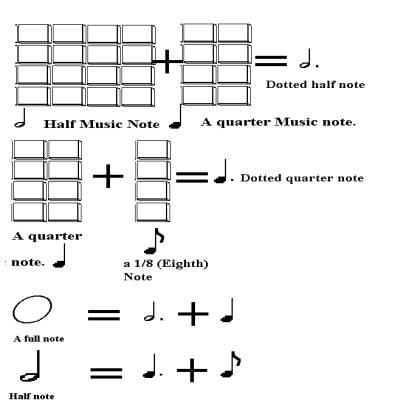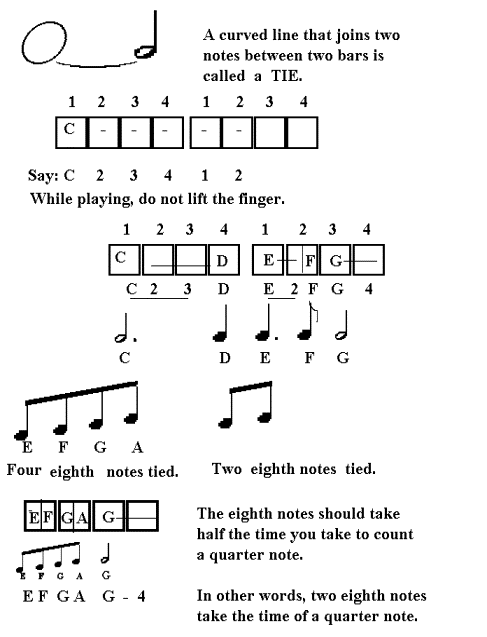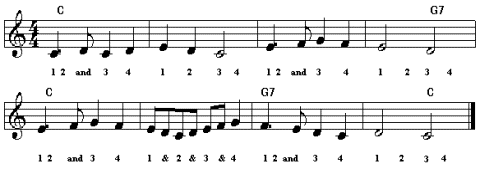MORE ABOUT DURATION

A full note = Semibreve. Half Note = Minim. Quarter Note = Crotchet..
Dotted Minim = 3 crotchets. Dotted Crotchet = 3 quavers.
An Eighth Note = a Quaver. One crotchet takes one beat.

Rest Symbols
Just as there are sound symbols, we also have rest symbols during which no music is played.
|
A whole note rest 4 counts
. Read-Count: X,2,3,4 |
|
Half note rest. 2 counts. Read-Count: X-2-G-4 |


|
A quarter note rest 1 count
Read-Count: X, F, G, A |

|
A quaver rest Half count
Read. Count. X-C B-A G - 4 |

In translation, indicate the rest by the letter “X”. The first example is translated as X 2 3 4. The second example as X 2 G 4. The third example: X F G A
and the last example: X/C. B/A.. G 4.
Remember that by translating, you “output” the information you have “input” in the process of study. In doing so, the mind is forced to think, and hence the learning process is strengthened. It is in your own interest to do so. A stage will come when you do not need to translate, when your mind can convert the information very fast.
I - a study in quavers.

When the quavers have to be played smoothly (i.e. unbroken), a bar is placed on top of the stems. The next finger should go down, as the previous one rises. Two quavers take the same time taken by a single crotchet. Play the notes evenly, to fit into the beat.
II. - a study of the dotted crotchet

The first three quavers of the group of 4, are having the same name/key. Do not raise the finger while playing them. While reading say: “cccd” E4; ddde F4; etc. The quavers have to be read at double the speed you take to say a crotchet.
III. - the above exercise written in the conventional way.

In the previous exercise we had 3 quavers on the C key. In fact a crotchet is made of 2 quavers represented by the first two quavers. The third is a quaver - half the value of the crotchet.
When a dot is placed after any note, it means, the note has to be lengthened by half its original value. Here the note with the dot, is called the dotted crotchet.
Translate the above exercise as follows: (traditional method)
|
1 |
2 |
3 |
4 |
1 |
2 |
3 |
4 |
1 |
2 |
3 |
4 |
1 |
2 |
3 |
4 |
|
C |
-/D |
E |
- |
D |
-/E |
F |
- |
G |
-/F |
E |
C |
D |
- |
C |
- |
Read as:
C 2/D E 4; D 2/E F4; G 2/F E C; D 2 C 4 - the note names are to be read at an even pace. Think of the soldiers’ march and how they take even steps.. However, when you name the quavers, two names are to be said in the time taken by one (step) count. An uneven pace will resemble the walk of a drunkard !
off-beat” or “pick-up”
In this exercise, count silently 1, 2, 3 and on the 4th beat, play C. This beat has no accent, and said to be on an “off beat” - some times called “pick up”. The first three counts are compensated in the last bar, which has a note of that value, and ends with a rest equivalent to the “pick up note”. Thus, if music starts on the 2nd beat, the last bar will have a note of 1 beat length (generally tied to a previous note).. If it starts on the third beat, the last note will have two beat length and two beat rest following it.. In case the tune is repeated, you must skip the rests, e.g. after the three beats of the last bar, go to the 4th beat of the first bar without interruption.

TRADITIONAL COUNTING METHOD:
When we start to play harmony, we have to play many notes at the same time, thus it is not possible to follow the Read Count and Play method in such cases. Hence we need to use the traditional method. The RCP method is useful to inculcate the note names and sense of duration in the early stages.
· Use numbers to count beats, according to the time signature. In the case of Common time, use the basic number structure of 1, 2, 3, 4. In the case of ¾ time, use: 1, 2, 3.
· When quavers are introduced, they happen to be fractions of the quarter notes. They are half a crotchet. Hence we use the word “and” to fill in the second half of the crotchet fraction:
· 1 and 2 and 3 and 4 and would be 8 consecutive quavers.
· 1 , 2 and 3 , 4 the first 1, 2 is the dotted crotchet, “and” is the following quaver. 3, 4 could be a minim or two crotchets.
Example 1.


Example 2.
When there are 2 semi quavers (half quavers) we say "and and".
Exercise 67 is in the F scale. Do for the singers is now in the original place of Fa. Rename all the notes above and below it accordingly. In the same way, Exercise 71 is in the G scale, thus the Do for the singers in the original place of Sol. Use the chart on pages 38 and 39 in the note in the Tonic Column is called the Do of the new scale Also note the exercises on Page 40 onwards. ALWAYS, SINGERS SHOULD RENAME THE NOTES, AS THEY WILL REACT TO THE NAME .OF THE NOTE THEY SING.
Additional Music Exercises for Chord and Voice and a beginning to sing in parts.
| < Prev | Next > |
|---|
















